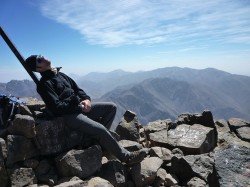
AMS is diagnosed according to the following three criteria:
- Height increase in last 4 days
- Presence of headache and the presence of at least one other symptom (loss of appetite, nausea, dizziness or fatigue);
- A total score of 3 or more on the Lake-Louise questionnaire
In making the diagnosis, AMS can be divided into mild, moderate and severe AMS, using the Lake-Louise questionnaire. The latter two are treated in the same way and are therefore grouped together for convenience.
MILDE AMS
The best treatment for any altitude-related illness is simply falling. Now, an individual with mild AMS does not need to immediately fallas the person in question is out of danger. However, it is recommended to take rest and to take the time to acclimatise adequately by staying at the same altitude. Symptoms can be suppressed with medication: for example, vomiting with metoclopramide and headaches with paracetamol. If the symptoms do not improve, however, you may decide to descend (at least 500 m to 1000 m) or administer medication to combat altitude sickness yourself.
An alternative to descending is oxygen therapy. Here, a person is connected to an oxygen tank, whereby 0.5 l - 2 l oxygen per minute is administered. With oxygen therapy, it is important to use the person's saturation as a measuring point. This is measured using a saturation meter, a small device that can be taken along on trips, which is applied to and around the finger. In this case, a saturation of 90% is desirable.
Roadmap mild AMS in brief:
- Stop rising
- Rest and acclimatisation: Twelve hours to three days
- Symptom relief possible with medication
- No improvement? Descend 500-1000m and acclimatise. Or oxygen therapy: 0.5 l - 2 l per minute until saturation rises >90%
- Medication under the guidance of a (medical) professional, if deemed necessary
MODERATE AND SEVERE AMS
Moderate to severe AMS becomes more problematic. What is important here is to be able to rule out High Altitude Cerebral Oedema (HACE), or fluid accumulation in the brain. The symptoms can be similar. The distinction is made on the basis of neurological signs, such as a drunken walk, altered mental status and confusion.
Once moderate and severe AMS has been diagnosed, ascending should be stopped immediately and descending should be performed (minimum 1000 m descent). Oxygen therapy can also be started immediately (0.5 l - 2 l per minute, saturation >90%). If available, a hyperbaric chamber can also be used. This is in fact nothing more than an enclosed space in which the pressure prevailing at a lower altitude is simulated. Effective in the short term, such a pressurised chamber can be used in combination with medication to bring the individual to a stable situation in order to then start the descent. The disadvantage, however, is that continuous care must be provided and the system is difficult to use with vomiting and claustrophobic patients.
Roadmap moderate/serious AMS in brief:
- Stop increase immediately
- Direct descent (>1000 m)
- Descent not possible? Oxygen therapy (0.5 l - 2.0 l, saturation >90%). Also during descent in very sick individuals. Or use of a hyperbaric chamber in combination with medication if necessary. Start descent after use (>1000 m).
- Medication under the guidance of a (medical) professional, if deemed necessary
When a person has AMS, it is possible to treat it with medication. The following medications and dosages are recommended:
- Acetazolamide
- Dexamethasone
